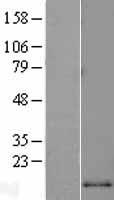MCP1 (CCL2) (NM_002982) Human Tagged ORF Clone
CAT#: RC202180
CCL2 (Myc-DDK-tagged)-Human chemokine (C-C motif) ligand 2 (CCL2)
ORF Plasmid: tGFP
"NM_002982" in other vectors (6)
Need custom modification / cloning service?
Get a free quote
CNY 1,800.00
CNY 3,705.00
CNY 300.00
CNY 2,700.00
CNY 3,790.00
Specifications
| Product Data | |
| Type | Human Tagged ORF Clone |
| Tag | Myc-DDK |
| Synonyms | GDCF-2; HC11; HSMCR30; MCAF; MCP-1; MCP1; SCYA2; SMC-CF |
| Vector | pCMV6-Entry |
| E. coli Selection | Kanamycin (25 ug/mL) |
| Mammalian Cell Selection | Neomycin |
| Sequence Data |
>RC202180 ORF sequence
Red=Cloning site Blue=ORF Green=Tags(s) TTTTGTAATACGACTCACTATAGGGCGGCCGGGAATTCGTCGACTGGATCCGGTACCGAGGAGATCTGCC GCCGCGATCGCC ATGAAAGTCTCTGCCGCCCTTCTGTGCCTGCTGCTCATAGCAGCCACCTTCATTCCCCAAGGGCTCGCTC AGCCAGATGCAATCAATGCCCCAGTCACCTGCTGTTATAACTTCACCAATAGGAAGATCTCAGTGCAGAG GCTCGCGAGCTATAGAAGAATCACCAGCAGCAAGTGTCCCAAAGAAGCTGTGATCTTCAAGACCATTGTG GCCAAGGAGATCTGTGCTGACCCCAAGCAGAAGTGGGTTCAGGATTCCATGGACCACCTGGACAAGCAAA CCCAAACTCCGAAGACT ACGCGTACGCGGCCGCTCGAGCAGAAACTCATCTCAGAAGAGGATCTGGCAGCAAATGATATCCTGGATT ACAAGGATGACGACGATAAGGTTTAA >RC202180 protein sequence
Red=Cloning site Green=Tags(s) MKVSAALLCLLLIAATFIPQGLAQPDAINAPVTCCYNFTNRKISVQRLASYRRITSSKCPKEAVIFKTIV AKEICADPKQKWVQDSMDHLDKQTQTPKT TRTRPLEQKLISEEDLAANDILDYKDDDDKV |
| Chromatograms |
CHROMATOGRAMS
 Sequencher program is needed, download here. |
| Restriction Sites |
SgfI-MluI
Cloning Scheme for this gene
Plasmid Map

|
| ACCN | NM_002982 |
| ORF Size | 297 bp |
| OTI Disclaimer | The molecular sequence of this clone aligns with the gene accession number as a point of reference only. However, individual transcript sequences of the same gene can differ through naturally occurring variations (e.g. polymorphisms), each with its own valid existence. This clone is substantially in agreement with the reference, but a complete review of all prevailing variants is recommended prior to use. More info |
| OTI Annotation | This clone was engineered to express the complete ORF with an expression tag. Expression varies depending on the nature of the gene. |
| Product Components | The ORF clone is ion-exchange column purified and shipped in a 2D barcoded Matrix tube containing 10ug of transfection-ready, dried plasmid DNA (reconstitute with 100 ul of water). |
| Reconstitution | 1. Centrifuge at 5,000xg for 5min. 2. Carefully open the tube and add 100ul of sterile water to dissolve the DNA. 3. Close the tube and incubate for 10 minutes at room temperature. 4. Briefly vortex the tube and then do a quick spin (less than 5000xg) to concentrate the liquid at the bottom. 5. Store the suspended plasmid at -20°C. The DNA is stable for at least one year from date of shipping when stored at -20°C. |
| Note | Plasmids are not sterile. For experiments where strict sterility is required, filtration with 0.22um filter is required. |
| Reference Data | |
| RefSeq | NM_002982.4 |
| RefSeq Size | 760 bp |
| RefSeq ORF | 300 bp |
| Locus ID | 6347 |
| UniProt ID | P13500 |
| Domains | IL8 |
| Protein Families | Druggable Genome, Secreted Protein |
| Protein Pathways | Chemokine signaling pathway, Cytokine-cytokine receptor interaction, NOD-like receptor signaling pathway |
| MW | 11 kDa |
| Gene Summary | This gene is one of several cytokine genes clustered on the q-arm of chromosome 17. Chemokines are a superfamily of secreted proteins involved in immunoregulatory and inflammatory processes. The superfamily is divided into four subfamilies based on the arrangement of N-terminal cysteine residues of the mature peptide. This chemokine is a member of the CC subfamily which is characterized by two adjacent cysteine residues. This cytokine displays chemotactic activity for monocytes and basophils but not for neutrophils or eosinophils. It has been implicated in the pathogenesis of diseases characterized by monocytic infiltrates, like psoriasis, rheumatoid arthritis and atherosclerosis. It binds to chemokine receptors CCR2 and CCR4. Elevated expression of the encoded protein is associated with severe acute respiratory syndrome coronavirus 2 (SARS‐CoV‐2) infection. [provided by RefSeq, Aug 2020] |
Documents
| Product Manuals |
| FAQs |
| SDS |
Resources
Other Versions
| SKU | Description | Size | Price |
|---|---|---|---|
| RC202180L1 | Lenti ORF clone of Human chemokine (C-C motif) ligand 2 (CCL2), Myc-DDK-tagged |
CNY 4,200.00 |
|
| RC202180L2 | Lenti ORF clone of Human chemokine (C-C motif) ligand 2 (CCL2), mGFP tagged |
CNY 4,200.00 |
|
| RC202180L3 | Lenti ORF clone of Human chemokine (C-C motif) ligand 2 (CCL2), Myc-DDK-tagged |
CNY 4,200.00 |
|
| RC202180L4 | Lenti ORF clone of Human chemokine (C-C motif) ligand 2 (CCL2), mGFP tagged |
CNY 4,200.00 |
|
| RG202180 | CCL2 (tGFP-tagged) - Human chemokine (C-C motif) ligand 2 (CCL2) |
CNY 3,400.00 |
|
| SC118317 | CCL2 (untagged)-Human chemokine (C-C motif) ligand 2 (CCL2) |
CNY 1,800.00 |


 United States
United States
 Germany
Germany
 Japan
Japan
 United Kingdom
United Kingdom
 China
China




